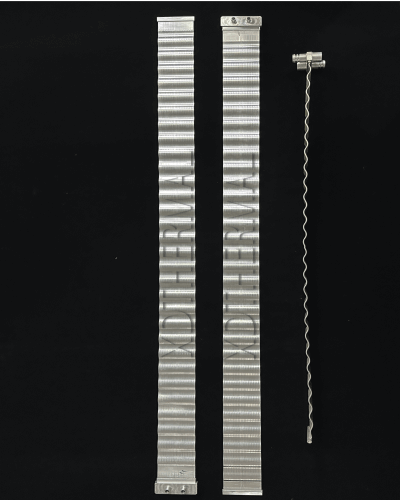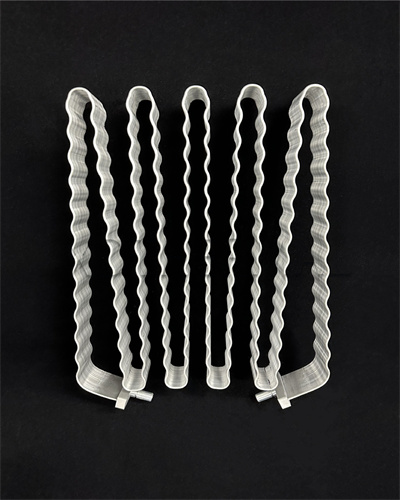마이크로 채널 냉각판은 전기 자동차(EV)의 설계 및 관리에서 점점 더 필수적인 요소가 되고 있습니다. 배터리 열 관리 시스템. 기계 엔지니어와 배터리 팩 통합업체는 이러한 혁신적인 액체 냉각 솔루션을 사용하여 최적의 온도를 유지하고 성능을 개선하며 EV 배터리의 수명을 연장합니다. 효과적인 EV 배터리 열 관리 시스템 통합을 위해서는 마이크로채널 냉각판 설계의 복잡성을 이해하는 것이 중요합니다.
마이크로채널 냉각판은 전기차 배터리 열 관리 시스템 내에서 효율적인 열 전달을 촉진하는 소형의 정밀 엔지니어링 채널로 설계되었습니다. 이 냉각판은 액체 냉각을 사용하여 배터리 셀에서 발생하는 열을 흡수하고 방출하여 일관된 성능과 안전성을 보장합니다. 따라서 고성능 전기 자동차의 열 관리에서 매우 중요한 구성 요소입니다.
전기차 배터리 열 관리 시스템에서 마이크로채널 냉각판의 구체적인 이점, 설계 고려 사항 및 통합 기술에 대해 알아보세요.
마이크로채널 콜드 플레이트는 전기차 배터리 시스템에 사용하기에 이상적인 여러 가지 이점을 제공합니다:
1. 향상된 열 관리:
마이크로 채널 냉각판은 최적의 배터리 온도를 유지하는 데 중요한 효율적인 열 방출 기능을 제공합니다. 이를 통해 배터리가 이상적인 열 범위 내에서 작동하여 과열을 방지하고 전반적인 성능을 향상시킬 수 있습니다. 예를 들어 단상 마이크로채널 콜드 플레이트 설계는 평균 0.112K/W의 열 저항을 달성하여 상당한 열 관리 기능을 입증했습니다(Dede, 2014).
2. 배터리 성능 및 수명 향상:
마이크로 채널 콜드 플레이트는 배터리 셀을 일정한 온도로 유지함으로써 배터리 수명을 연장하는 데 도움이 됩니다. 이는 전기차의 신뢰성 향상과 작동 수명 연장으로 이어집니다. 모듈식 설계로 다양한 구성을 통해 냉각 성능을 최적화할 수 있어 다양한 열 관리 요구 사항을 유연하게 처리할 수 있습니다(Zhou 외, 2015).
3. 스트레스가 많은 환경에서의 안전과 신뢰성:
효과적인 열 관리는 전기차 배터리의 안전을 위해 매우 중요합니다. 마이크로채널 냉각판은 배터리 고장이나 화재로 이어질 수 있는 열 폭주를 방지하는 데 도움이 됩니다. 적절한 냉각수 선택과 설계 구성은 냉각판의 열 및 유압 성능에 큰 영향을 미칠 수 있습니다(Hoang et al., 2021).
마이크로채널 냉각판은 열 관리를 최적화하기 위해 전기차의 다양한 구성 요소에 통합되어 있습니다:
배터리 셀과 통합: 냉각판은 개별 배터리 셀을 냉각하는 데 사용되어 전체 배터리 팩에 균일한 온도 분포를 보장합니다.
전력 전자 장치 냉각에 사용: 마이크로 채널 냉각판은 배터리 셀 외에도 전기차 작동에 중요한 인버터 및 제어 장치와 같은 전력 전자 장치를 냉각하는 데도 사용됩니다.
최적의 작동 온도 유지를 위한 역할: 마이크로 채널 냉각판은 작동 중 발생하는 열을 관리하여 전체 전기차 시스템의 효율적이고 안전한 성능에 필요한 최적의 작동 온도를 유지하도록 도와줍니다.
몇 가지 유형이 있습니다. 마이크로 채널 원통형 냉각 파이프 전기차 배터리 시스템에 사용되며 각각 다른 애플리케이션에 적합합니다:



냉각 튜브에는 여러 종류가 있습니다. 그러나 공통적으로 몇 가지 단계가 있을 수 있습니다:
재료 준비: 예를 들어, 전단.
흐름 채널/내부 구조: 예를 들어, 압출.
커넥터/액세서리 처리: 예: 입구 및 출구.
용접: 예: 브레이징, FSW, CMT.
표면 처리: 예를 들어, 광택, 단열 코팅.
테스트 및 검증.
EV 배터리 시스템에 마이크로채널 냉각판을 성공적으로 통합하려면 몇 가지 설계 고려 사항이 중요합니다:
공통 재료: 구리 및 알루미늄: 구리 및 알루미늄은 열전도율이 우수하고 제조가 용이하여 마이크로 채널 냉각판에 가장 일반적으로 사용되는 소재입니다.
전기차 애플리케이션의 장단점: 구리는 우수한 열 성능을 제공하지만 알루미늄보다 무겁고 가격이 비쌉니다. 반면 알루미늄은 더 가볍고 비용 효율적이지만 구리에 비해 열전도율이 낮습니다. 소재 선택은 전기차 설계의 특정 요구 사항과 제약 조건에 따라 달라집니다.
EV 배터리 시스템에 마이크로채널 냉각판을 성공적으로 통합하려면 몇 가지 설계 고려 사항이 중요합니다:
유압 직경 및 채널 구성: 유압 직경과 구성을 포함한 마이크로 채널의 설계는 냉각 효율에 큰 영향을 미칩니다. 효과적인 열 전달을 위해서는 이러한 매개변수를 최적화하는 것이 필수적입니다.
배터리 팩 아키텍처와의 호환성: 냉각판 설계는 배터리 팩의 전체 아키텍처와 호환되어야 하며, 원활한 통합과 효과적인 열 관리를 보장해야 합니다.
효율적인 액체 냉각 경로 보장: 액체 냉각 경로가 효율적이고 과도한 압력 강하나 흐름 제한이 발생하지 않도록 설계해야 합니다.
마이크로 채널 냉각판을 전기차 배터리 시스템에 통합하는 데는 몇 가지 어려움이 있습니다:
냉각 효율과 무게 및 공간 제약의 균형 맞추기: 마이크로 채널 냉각판은 높은 냉각 효율을 제공하지만, 전기차의 무게와 공간 제약에 맞게 설계되어야 합니다.
제조 및 비용 관련 문제 해결: 마이크로 채널 냉각판의 제조 공정은 복잡하고 비용이 많이 들 수 있습니다. 성능 저하 없이 비용 효율적인 제조 기술을 찾는 것이 중요합니다.
다양한 조건에서 신뢰성 및 내구성 보장: 냉각판은 내구성과 신뢰성이 뛰어나고 다양한 작동 조건과 온도에서 작동할 수 있어야 합니다. 부식 거동을 포착하기 위한 흐름 루프 설계 연구에서 입증된 바와 같이 부식과 같은 문제를 해결함으로써 이러한 시스템의 신뢰성을 향상시킬 수 있습니다(키니 외, 2020).
마이크로채널 냉각판은 다른 냉각 방식에 비해 뚜렷한 이점을 제공합니다:
직접 칩 냉각도 효과적이지만, 마이크로채널 냉각은 특히 대형 배터리 팩의 경우 더욱 균일하고 효율적인 열 관리를 제공합니다.
마이크로채널 냉각판이 제공하는 액체 냉각은 공냉식 냉각보다 훨씬 효율적이어서 열 방출과 열 관리가 더 잘 이루어집니다.
마이크로채널 냉각판은 뛰어난 냉각 성능을 제공하므로 고성능 및 안전이 중요한 전기차 애플리케이션에서 기존 방식보다 선호되는 선택입니다.
마이크로채널 냉각판은 전기차 배터리 시스템의 열 관리에 중요한 역할을 하며 성능, 안전성, 수명 측면에서 상당한 이점을 제공합니다. 엔지니어와 배터리 팩 통합업체는 설계 원칙과 통합 기술을 이해함으로써 전기 자동차의 효율성과 신뢰성을 향상시키는 정보에 입각한 결정을 내릴 수 있습니다. 이 기술을 수용하는 것은 미래 전기차의 기능과 성능을 발전시키는 데 필수적입니다.

저는 5년 넘게 배터리 열 관리 분야에서 일하면서 수많은 국제 프로젝트를 처리했습니다. 배터리 액체 냉각 제품이나 서비스에 대해 궁금한 점이 있으면 언제든지 문의해 주세요!